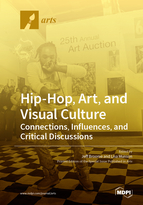Hip-Hop, Art, and Visual Culture: Connections, Influences, and Critical Discussions
A special issue of Arts (ISSN 2076-0752). This special issue belongs to the section "Musical Arts and Theatre".
Deadline for manuscript submissions: closed (30 September 2018) | Viewed by 45488
Special Issue Editors
Interests: narrative inquiry; cultural diversity; hip-hop and art education; caring approaches to art curricula; multi-age art education
Interests: qualitative research methods; comparative and international education; sociology; hip-hop culture; social justice and urban education; intersectionality and social inequality; graffiti, street art, writing, and ephemerality; musicology
Special Issue Information
Dear Colleagues,
Visual art has been tied to hip-hop culture since its inception, and initially manifested itself most clearly in the form of graffiti and fashion trends. During the genre’s first decades, notable hip-hop practitioners whose work crossed the boundaries of music and visual art included Fab 5 Freddy, Rammellzee, and Jean-Michel Basquiat. More current examples of cross-disciplinary connections between hip-hop and visual art include the efforts of Swizz Beatz, Ecletic Method, and the Hi-ARTS non-profit organization for advancing educational hip-hop projects in the arts. Simultaneously, references to visual artists have appeared more frequently in the lyrics of hip-hop musicians such as Jay-Z, Nas, Kanye West, Rick Ross, and Lil Wayne.
In short, hip-hop has become a global phenomenon influencing many facets of society, including art, education, and visual culture. The possibilities of this influence have not gone unnoticed, and a number of scholars have discussed the connections between hip-hop and visual art, fashion, and postmodernism, while others have critically examined hip-hop’s influence on visual culture.
We invite potential contributors to join these ongoing conversations by submitting manuscripts to be considered for inclusion in a Special Issue of Arts on the topic of "Hip-Hop, Art, and Visual Culture".
Some of the topics and questions that can be addressed in this issue, include, but are not limited to:
- How have hip-hop practitioners’ relationships with visual art changed over time?
- In what ways can hip-hop be used in classrooms as a tool to foster critical discussions related to visual culture, cultural appropriation, postmodernism, and/or aesthetics?
- What has been the effect of name-dropping artists like Basquiat and Warhol on popular rap songs? How has this contributed to art as a symbol of luxury or a form of investment in contemporary hip-hop?
Dr. Jeff Broome
Dr. Lisa Munson
Guest Editors
Manuscript Submission Information
Manuscripts should be submitted online at www.mdpi.com by registering and logging in to this website. Once you are registered, click here to go to the submission form. Manuscripts can be submitted until the deadline. All submissions that pass pre-check are peer-reviewed. Accepted papers will be published continuously in the journal (as soon as accepted) and will be listed together on the special issue website. Research articles, review articles as well as short communications are invited. For planned papers, a title and short abstract (about 100 words) can be sent to the Editorial Office for announcement on this website.
Submitted manuscripts should not have been published previously, nor be under consideration for publication elsewhere (except conference proceedings papers). All manuscripts are thoroughly refereed through a double-blind peer-review process. A guide for authors and other relevant information for submission of manuscripts is available on the Instructions for Authors page. Arts is an international peer-reviewed open access semimonthly journal published by MDPI.
Please visit the Instructions for Authors page before submitting a manuscript. The Article Processing Charge (APC) for publication in this open access journal is 1400 CHF (Swiss Francs). Submitted papers should be well formatted and use good English. Authors may use MDPI's English editing service prior to publication or during author revisions.
Keywords
- hip-hop
- visual culture art education
- hip-hop and postmodernism
- hip-hop and aesthetics
- graffiti
- culturally responsive pedagogy






